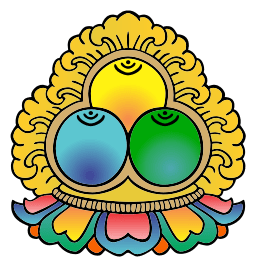
Taking Refuge in the 3 jewels is a Buddhist ceremony that initiates a person as a formal Buddhist. Refuge is taken in the three jewels (Tibetan – Norbus): the Buddha as guide, the Dharma as teachings, and the Sangha as the assembly.
Table of Contents
Explanation of Refuge and the 3 jewels in Buddhism
Taking refuge, the first ceremony announcing yourself to be Buddhist, essentially signifies that you have analyzed the teachings sufficiently and agree to what is being said. Especially the four Noble Truths and the 3 marks of existence. At this point, you would wish to make it your spirituality.
Trungpa Rinpoche famously taught that taking refuge meant ‘becoming a refugee.’ Meaning not going for normal worldly occupation, not looking to money, career, relationships, home and safety, or any material, temporary phenomena to create happiness. It means knowing, at least intellectually, that lasting, stable happiness or peace can never come from the eight worldly dharmas.
Taking refuge means acknowledging the 3 marks of existence:
- Impermanence – All composite phenomena will fall apart
- Egolessness – the permanent, singular, independent self does not exist
- Suffering – being in existence will cause suffering to arise.
It also means taking to heart the 4 Noble Truths:
- Suffering
- Cause of suffering
- Cessation of suffering
- The path to cessation
When a person takes refuge, they make an implicit vow to not cause harm. This typically means taking on most or all of the 5 precepts:
How to meditate like a yogi
and enter profound samadhi
Buddhist precepts explained
- Do not take life
- Do not take what is not offered (stealing)
- Do not lie
- Do not engage in intoxicants
- Do not commit sexual misconduct
The act of taking refuge should ideally be born of faith in the Buddha as example, in the teachings as truth, and in the sangha of bodhisattvas. That faith has strong trust that the teachings can guide you out of the cycle of rebirth.
Buddhist Ritual of going for Refuge
The initial time to take refuge is often given by a preceptor, who ‘gives’ one the vow. A name – Sangye Chodrak, for example – is given at the time, called the refuge name. First, face the shrine or an image of the Buddha or visualize or think of the Buddha and his retinue – Aviloketeshvara and Shariputra and so forth.
Perform three half-prostrations – touching hands in anjali (prayer mudra) to the forehead, throat, and heart, then kneeling and touching the palms and forehead to the floor, then rising.
From a kneeling position (optional right knee raised), with hands in anjali, repeat the refuge formula three times:
I take refuge in the Buddha
I take refuge in the Dharma
I take refuge in the Sangha
And that’s it. Most practicing Buddhists take refuge in some form every day. It is usually included at the opening section of longer practices.
Buddha, the Teacher
What is the meaning of the 3 jewels – Buddha, dharma and sangha?
The primary object of refuge is the Buddha. In fact, the teachings and retinue can be seen as emanations of the Buddha, or in the higher teachings, as emanations of buddha nature. From a relative perspective, Buddha is the example and teacher. He is the first person in our world who traveled the bodhisattva path to completion, a path that is supposed to require many immeasurable kalpas or eons.
Contemplating the stories and philosophy is beneficial. The three jewels have both a relative and an absolute meaning. Siddhartha, of course, was a great bodhisattva, who at birth was prophesied to become either a universal monarch who would bring great benefit to his subjects, or a Buddha, an awakened one. He chose to become a Buddha or was compelled to do so by his merit. He escaped from the palace at a young age and became an ascetic wanderer.
During his practice, after practicing renunciation, while meditating under the bodhi tree, he found an ‘uncompounded state,’ a state not dependent on causes and conditions, which naturally abides always, but is unseen. He remained in that state without fail and thus attained enlightenment. With some urging he turned the wheel, teaching dharma. His first teaching was the 4 Noble Truths. Therefore, the 4 Noble Truths is a central philosophical teaching for all Buddhists. Some people would say that this teaching encompasses all Dharma teachings.
Buddha performed the 12 acts of a Buddha:
- Descent from the pure land
- entering the womb
- taking birth
- becoming skilled in various arts
- enjoying the company of royal consorts
- Renouncing the world
- practicing austerity for six years
- Meditating under the bodhi tree
- Defeating the hosts of deception, Mara
- Attaining complete enlightenment
- turning the wheel of Dharma teachings
- passing into parinirvana, the passing of an enlightened being
From an inner or absolute perspective, Buddha is your own mind. It is who you are at the deepest level. And everyone else and all that lives for that matter. Buddhahood can be cultivated within the mind, so you take refuge at that level in your own awakenment, your ability to become enlightened. That seed, called bodhicitta, is also the Buddha. The human Buddha becomes the supreme example of that.
Dharma, the protector
The Dharma has multiple meanings as well. With a capital D, it means the truth that Buddha taught. Small ‘d’ dharma is manifest phenomena. The teachings of Buddha have 2 levels – Trangdon, provisional meaning, and ngedon- the definitive meaning.
The Trangdon would be the Hinayana, especially the vinaya, rules of behavior, karma, and so forth. Hinayana ngedon would be the lack of self in the person.
Dharma as teaching means that which applies to all beings everywhere at all times. It is universal law or truth. Understanding the Dharma leads to liberation if fully applied and realized. Taking refuge in the Dharma means to take refuge in the truth of reality itself.
Sangha, the community
Finally, we take refuge in the assembly or Sangha in Sanskrit. This can be seen as the community of bodhisattvas and the teachers alive today. Or simply the other practitioners one is walking the path with. The Tibetan word for Sangha is Gendun, which means Gathering of Virtue.
Part of taking refuge in the bodhisattvas is having guides along the path because the Buddha is no longer around, but, it is said, that bodhisattvas still walk among us. Most of the Rinpoches (precious jewel) the Tibetan dharma teachers are considered to be genuine bodhisattvas.
As to your fellow practitioners, as the Sangha they can help you with more mundane difficulties, but also irritate you, giving you something to practice with. You are supposed to love all beings, but your fellow practitioners can often be challenging. The practice is one of not giving in to disliking them.
Probably the best contemplation on the three jewels is the Sutra (direct teaching of the Buddha) of the Recollection of the Noble Three Jewels, which is especially beautiful and helpful.

Flow, the profound mental state, also called Peak Performance, can be attained with meditation and can be ‘triggered’ at will, with enough discipline. Guide to Flow Mastery will teach you how.
THE SUTRA OF THE RECOLLECTION OF THE NOBLE THREE JEWELS
I prostrate to the omniscient one.
Thus, the Buddha, bhagavat, tathågata, arhat, samyaksambuddha, the wise and virtuous one, the sugata, the knower of the world, the charioteer and tamer of beings, the unsurpassable one, the teacher of devas and humans, is the buddha bhagavat.
The tathågata is in accord with all merit, which is his source. He does not waste the roots of virtue. He is completely ornamented with all patience. He is the basis of the treasures of merit. He is adorned with the excellent minor marks. He blossoms with the flowers of the major marks.
His activity is fitting and appropriate. The sight of him brings no disharmony. He brings true joy to those who long with faith. His knowledge cannot be overpowered. His strengths cannot be challenged. He is the teacher of all sentient beings. He is the father of bodhisattvas. He is the king of noble ones. He is the guide of those who journey to the city of nirvana.
He possesses immeasurable wisdom. He possesses inconceivable confidence. His speech is completely pure. His melody is pleasing. One never has enough of seeing him. His form is incomparable. He is not stained by the realm of desire. He is not stained by the realm of form. He is not affected by the formless realm.
He is completely liberated from suffering. He is completely and utterly liberated from the skandhas. He does not possess the dhåtus. His åyatanas are controlled. He has completely cut the knots.
He is completely liberated from extreme torment. He is liberated from craving. He has crossed over the river. He is perfected in all the wisdoms. He abides in the wisdom of the buddha bhagavats, who arise in the past, present, and future. He does not abide in nirvana.
He abides in the ultimate perfection. He dwells on the bhými where he sees all sentient beings. All these are the perfect virtues of the greatness of the buddha bhagavat.
The holy dharma is good at the beginning, good in the middle, and good at the end. Its meaning is excellent. Its words are excellent. It is uncorrupted. It is completely perfect and completely pure. It completely purifies.
The bhagavat teaches the dharma well. It brings complete vision. It is free from sickness. It is always timely. It directs one further. Seeing it fulfills one’s purpose. It is known by the wise through their own insight.
The dharma spoken by the bhagavat teaches taming well. It is renunciation. It causes one to arrive at perfect enlightenment. It is without contradiction. It is all-inclusive. It is trustworthy and puts an end to the journey.
As for the sangha of the great yåna, they enter completely. They enter insightfully. They enter straightforwardly. They enter harmoniously. They are worthy of veneration with joined palms. They are worthy of receiving prostration. They are a field of glorious merit. They are completely capable of receiving all gifts. They are an object of generosity. They are always a great object of generosity.
Translated by the Nalanda Translation Committee, under the direction of Vidyådhara the Venerable Chögyam Trungpa Rinpoche. © 1975, 1980 by the Nålandå Translation Committee. All rights reserved. Available on our website for personal use.
A shorter three refuges chant is often done to offer meals before eating:
The unsurpassable teacher is the precious Buddha
The unsurpassable protector is the precious holy Dharma
The unsurpassable guide is the precious Sangha
To the unsurpassable three jewels, I make this offering
faq
What do the 3 jewels represent in Buddhism?
The 3 jewels in Buddhism represent Buddha, dharma (teachings), and sangha (community).
What are the 3 main beliefs of Buddhism?
The 3 main beliefs of Buddhism are the 4 Noble Truths, the Emptiness of all phenomena, and the teaching of compassion.
What are the three jewels that a Buddhist takes refuge in?
The three jewels for a Buddhist to take refuge in are Buddha, the teacher, dharma, the teachings, and sangha, the community.
Why are the 3 jewels important?
The 3 jewels are important because they represent all that is essentially needed to walk the path of dharma. They are the 3 refuges from the miseries of samsara.
What is another term for the triple gem of Buddhism?
The triratna of Buddhism or the 3 jewels is another term for the triple gem in Buddhism.
What does taking refuge mean in Buddhism?
Taking refuge in Buddhism means seeking protection from suffering and relying on objects of wisdom that have escaped the cycle of existence, therefore being able to teach the path out of suffering.
What three things do Buddhists take refuge in?
Buddhists take refuge in three things: Buddha as teacher or example, Dharma as teachings, truth, or protector, and sangha, as community.
What are the benefits of taking refuge in Buddhism?
The benefits of taking refuge in Buddhism are many: a teacher who is committed to helping others and has the wisdom to show the way. A path that guides one out of samsaric suffering. A truth that explains many of the challenges in life. Also, a community of like-minded practitioners.
Can you be a Buddhist without taking refuge?
You cannot be a Buddhist without taking refuge in the 3 jewels. That is the defining characteristic of being a Buddhist. It is possible to act in accord with the dharma, however.
Why is it important to take refuge?
It’s important to take refuge so that the mind does not seek refuge in samsaric phenomena that cannot provide refuge, but only temporary relief. Nirvana does not end.
Do Zen Buddhists take refuge?
All Buddhists, including Zen Buddhists, take refuge.
Summary of the Three Jewels
The three jewels are the Buddha, Dharma (teachings), and Sangha (community or retinue). Taking refuge in them to attain liberation from samsara is the essential act that a person must perform to become a Buddhist. Many Buddhists retake refuge daily as part of their practice. In fact, most practices include at least a brief section of taking refuge.

May all beings be happy
May all beings be peaceful
May all beings be safe
May all beings awaken to the light of their true nature
May all beings be free







